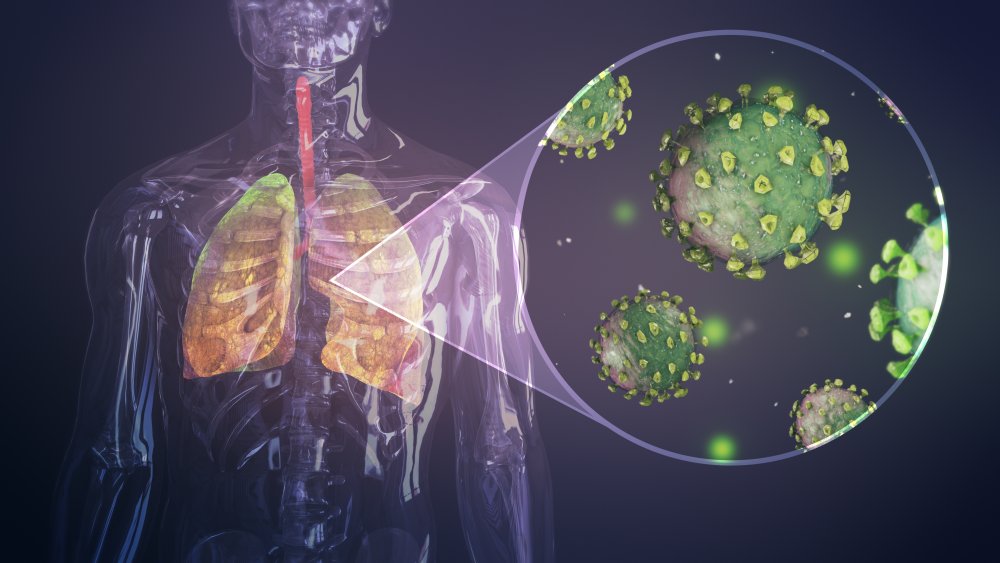The Messed Up History Of MERS
Per the World Health Organization, MERS, also known as MERS-CoV, or Middle East Respiratory Syndrome Coronavirus, is a virus transferred to humans from infected animals — in this case, dromedary camels, the ones with one hump. MedicalNewsToday reports that MERS-CoV was first discovered in Saudi Arabia September 20, 2012, when the Program for Monitoring Emerging Diseases "reported a novel coronavirus isolated from sputum samples of a 60-year-old man." Since then, 27 countries have reported a total of 2,519 cases and 828 known deaths due to infection or related complications, which means 35 percent of those who have contracted MERS have died. Like other coronaviruses, such as SARS and COVID-19, researchers think it "originated in bats and later transmitted to camels at some point in the distant past."
Symptoms of MERS are similar to the flu, including, says the CDC, "fever, cough, and shortness of breath." While there is a high fatality rate among those who contract the virus, "most of the people who died had a pre-existing medical condition that weakened their immune system, or an underlying medical condition that hadn't yet been discovered," including cancer, diabetes, or chronic lung, kidney, or heart disease. The virus "likely spreads from an infected person's respiratory secretions, such as through coughing," but there's no exact certitude regarding the precise ways it spreads. There are no examples of ongoing spreading happening within communities; transmission is most likely via "close contact, such as caring for or living with an infected person."
How do MERS and COVID-19 differ?
How is the coronavirus that causes MERS different from what causes COVID-19? Per Healthline, coronaviruses "are a very diverse family of viruses" with "a large host range, which includes humans." Says the World Health Organization, "although most of human cases of MERS-CoV infections have been attributed to human-to-human infections in health care settings, current scientific evidence suggests that dromedary camels are a major reservoir host for MERS-CoV and an animal source of MERS infection in humans." MERS has remained relatively contained, particularly compared to COVID-19, as the majority of the world population aren't in health care settings or in regular contact with camels: "(N)o sustained human to human transmission has been documented anywhere in the world." Nevertheless, WHO reports in its July of 2019 MERS Global Summary and Assessment of Risk, "MERS-CoV is still a relatively rare disease about which medical personnel in health care facilities have low awareness." It's important to practice "adherence to the standard precautions at all times" in order to prevent transmission within health care settings.
Of the 219 cases of MERS reported between July 2018 and July 2019, 53 were fatal. Of those, 79 percent of the people who died of MERS were male, with a median age of 52. Just over 22 percent of those patients were asymptomatic or had mild reactions. Nearly all of the people who died lived in Saudi Arabia, with 13 in Oman and 1 each in South Korea and the United Kingdom.
Beware of camels
MERS is unique. While it's known that coronaviruses that affect humans originate in animals, MERS has a clear and specific link to camels. WHO notes that "populations in close contact with dromedaries (e.g. farmers, abattoir workers, shepherds, dromedary owners)" are at a higher risk of contracting MERS. This is not the first time that human interactions with animals have been discussed in relation to coronaviruses. In a 2007 review of the book SARS: How a Global Epidemic Was Stopped, the Bulletin of the World Health Organization noted that "animal husbandry and marketing practices seriously affect human health." The review was pointing specifically to avian influenza, also known as H1N5, or "bird flu," which was then an immediate public health concern. Their observation — "old and unhygienic veterinary practices must be discarded or the public health risk from zoonotic diseases will always be with us" — will probably remain applicable to current and future management of coronaviruses.
WHO recommended best practices in this realm: One, "transparency is the best policy," which means governments must acknowledge, accept, and communicate the seriousness of coronaviruses' effects on public health. Two, "openness and willingness to share critical scientific information promptly," which asks scientists and health professionals to work together across their countries' borders and share information and resources in order to help keep people everywhere healthy and informed.


